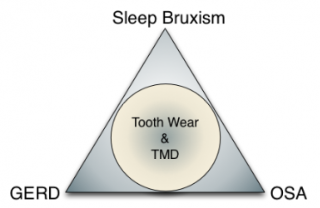Unraveling the Mysteries of Extensive Tooth Wear: Part I
By Vivek Mehta on July 12, 2013 | 7 comments
 Extensive tooth wear is often the result of a triad of three underlying interconnected conditions: Sleep Bruxism (SB), Gastroesophageal reflux disease (GERD) and Obstructive Sleep Apnea (OSA). A checklist of signs and symptoms provided for each of these conditions could help in identifying such patients.
Extensive tooth wear is often the result of a triad of three underlying interconnected conditions: Sleep Bruxism (SB), Gastroesophageal reflux disease (GERD) and Obstructive Sleep Apnea (OSA). A checklist of signs and symptoms provided for each of these conditions could help in identifying such patients.
Sleep Bruxism [1] Sleep Bruxism is the grinding or clenching of teeth during sleep, which is preceded by sleep arousals. Sleep Arousal is a naturally occurring 3-10 second shift occurring during deep sleep, which is accompanied by an increase in muscle tone. This motor activity causing clenching and grinding activity of jaw muscles is believed to be an attempt to open the constricted airway. Sleep bruxism occurs in multiple episodic bursts throughout the night. Some episodes may produce audible grinding noise. Incidences of Sleep Bruxism is higher in children and then decreases with age. It is found in 8 percent of the general population and 14-20 percent of children. A constricted airway due to Adenoid and tonsil hypertrophy is often the cause for a constricted airway in children, which opens up with age.

Obstructive Sleep Apnea [2] Obstructive Sleep Apnea is characterized by frequent episodes of stopped or very shallow breathing, each lasting 10 seconds or more. It's caused by an obstruction of the upper airway because of inadequate motor tone of the tongue and/or airway dilator muscles. Diagnosis usually requires overnight polysomnography to detect the frequency of apnea (stopped breathing) and hypoapnea (very shallow breathing) events. The apnea-hypoapnea index (AHI) is the average number of disordered breathing events per hour. Typically OSA syndrome is defined as an AHI of five or greater with associated symptoms (e.g., excessive daytime sleepiness, fatigue, etc.) or an AHI of 15 or greater, regardless of associated symptoms. Increased muscle tone and micro arousals caused by sleep apnea events are the trigger factors for sleep bruxism.
GERD [3] GERD is characterized by leak of stomach contents into the esophagus. Typical symptoms are heartburn and regurgitation (the perception of gastric contents moving from the stomach into the esophagus). Sleep Apnea episodes are often implicated as a contributing etiology of GERD and SB. Increased negative pressure in intra thoracic space during apneic episode causes gastric acid to expel into the esophagus. This triggers micro arousals leading to Sleep Bruxism. In Part II, I'll discuss a checklist of warning signs and include a questionnaire.
References
1.Rouse, Jeffrey S. "The Bruxism Triad." Inside Dentistry (2010): 32-44.
2. Park, John G., Kannan Ramar, and Eric J. Olson. "Updates on definition, consequences, and management of obstructive sleep apnea." Mayo Clinic Proceedings. Vol. 86. No. 6. Elsevier, 2011.
3. Miyawaki, Shouichi, et al. "Association between nocturnal bruxism and gastroesophageal reflux." Sleep New York Then Westchester- 26.7 (2003): 888-892.
Vivek Mehta DMD, FAGD, Visiting Faculty, Spear Education
Comments
July 13th, 2013
July 13th, 2013
July 15th, 2013
July 15th, 2013
July 15th, 2013
July 15th, 2013
August 8th, 2013